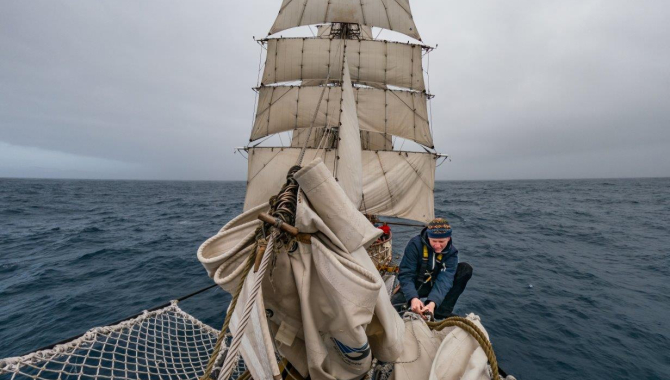Leaving Cape Horn behind on our way to the Falkland Islands

Cape Horn is now behind us. Our next goal is to sail northwards to 50ºS along the Atlantic coasts.
From close-hauled last night to a downwind course this morning, beam reach in the late afternoon, braced sharper during the night. Northerlies have become northwesterlies, westerlies, and then even backed to a SW light breeze, just to veer again and start gently blowing from the northwest. We follow them on a course that will eventually bring us around Staten Island.
But the seas are calm, and the winds aren’t blowing with enough consistent force. It is well known that this area is characterized by the variable conditions, as it is sheltered by Tierra del Fuego and the island groups south of it. Days of strong winds and rough seas are frequent, but so are the calms, variable weather, and passing showers.
Europa slowly makes her way to the east and northeast, now pulled by a bit of a blow, now basically drifting.
Conditions that are great for having a slow, steady ship and a calm day aren’t the best ones for sailing or for flying. One of the day’s highlights has been the numerous albatrosses and petrels that keep trying to glide low over the calm sea surface but often land in the water, waiting for a bit of wind to keep flying. It is tiresome for them to have to flap their large wings, in contrast with the much more effective and almost effortless soaring. Like that, they have been catching up with the Europa, sitting in the water letting her slowly pass, flying again around and ahead of her to sit and wait once more. A routine that groups of southern giant petrels and southern royal albatrosses have been performing all day. Amongst them, some of their relatives: the wandering and black-browed albatrosses, cape and storm petrels, southern fulmars, and sooty shearwaters.
The great albatrosses are amongst the most spectacular sights of the Southern Ocean, sharing the record for the longest wingspan of any bird.
Besides subtle differences in plumage and beak details, their nesting places differ. Wanderers breed at twelve island groups around the Southern Ocean, while the southern royals have a much more restricted breeding ground on Campbell and Auckland Islands, south of New Zealand. But they range all the way along offshore waters in the entire South Pacific, keeping themselves north of the Antarctic Convergence. They can often be seen in the South Atlantic, from waters close to the Argentinean coast to South Georgia as well.
And today, slowly sailing along the eastern tip of Tierra del Fuego, we had many. Wandering and royals, often misidentified when at sea, today allowed us to sail close by, making for easier identification.
The story of separating these species goes back to the 18th century, when they were first described by Linnaeus in 1758, but not from a hands-on specimen.
To have a more proper identification, we have to look back and talk again about one of the most influential expeditions that sailed and explored the South Pacific. In charge of it, the pioneer Captain James Cook and his ship, the Endeavour, on her world circumnavigation during the years 1768–71. Aboard was the naturalist Joseph Banks, who used this only available description to name the bird they shot when they were sailing close to Rio de la Plata. That was the first time a wandering albatross was studied in detail by naturalists firsthand.
In 1825, a slightly different great albatross was noticed, but the lack of data and collected specimens made it difficult to name it as a different species. The southern royal had to wait until 1888 to be widely accepted as a distinct species.
Both are nomadic scavengers and they fish too over wide expanses of the ocean. And there they were today, quite a large group of royals and a handful of wanderers, often landing and checking kelp rafts, which, when they are afloat and drifting, bring with them many associated communities of invertebrates and small fish.
Not just this, but it was beautiful too to see the royals preening, bonding, and socializing—a good chance, with the calm weather, to gather after their lonely transoceanic flights. A behavior not so usual to see while sailing and having them so far away from their nesting islands, just at the opposite side of the Pacific Ocean, where we both seem to come from, for sailing or flying this long voyage from the New Zealand waters.